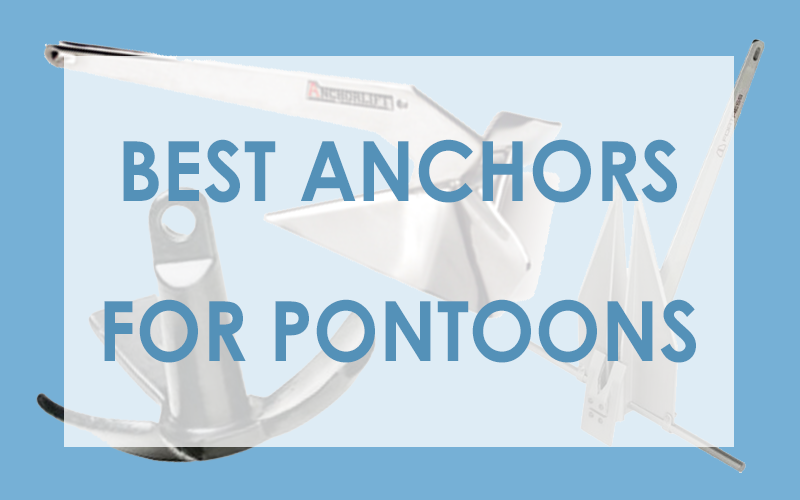Best Anchor Types for Your Pontoon
It seems easy enough to just get the anchor overboard and drop it in the water. You just need some muscle and a solid line to hold the anchor and bang! It’s all done. However, things are not as simple in reality. Of course, if you’re on a very small boat like a canoe or something similar, dropping a rock tied to the boat will do just fine. The average 22’ pontoon boat, on the other hand, with a tank full of gas and a couple of people on it, is around 3000 pounds, which is about 2700 more than the average canoe, human included. What’s more, due to its height, a pontoon boat is more easily affected by wind and waves, which in turn puts more strain on both anchor and line.
The bottom line (sorry for the bad pun) is that anchoring a pontoon boat isn’t as easy as it appears to the untrained eye. It requires care, knowledge of how the bottom of the water looks, and a proper anchor above all. There is more than one type of anchor that you can use, even if you leave out the classic cartoon anchor design. Each of these types works well with certain underwater environments while not being as compatible with others. Here are the three types of anchors which a pontoon boat captain would find most useful:
Table of Contents
1. The fluke anchor: works best for a sand/gravel bottom
This type of anchor is a wedge-shaped piece of steel designed to dig into the bottom of the water and stay there. It totally disproves the general public impression that an anchor needs to be extraordinarily heavy; in fact, a relatively small anchor (15-20 pounds) can successfully hold a 24’ boat even in harsher conditions, or a big 30’ one on a relatively calm lake.
When you purchase a fluke anchor, you must think of two important factors: size and weight. The anchor size must be proportional to the boat size, as the bigger the anchor, the bigger the boat it can hold. It’s basically the grip it has on the bottom that makes it hold firmly. The weight of the anchor must be proportional to the bottom resistance. For instance, a muddy bottom is easier to dig into than a sand bottom, which requires a heavier anchor in order to be properly driven into the ground.
The design also matters a bit. While generally most of these anchors look the same, there are nonetheless small differences in angles and such which may prove important for the grip solidity.
If you’re going for a fluke anchor, we recommend the 18 pounds Tie Down Engineering Super Hooker Anchor. Find it here:
2. The box anchor: works best for muddy bottom, river bottom, and light vegetation
An all-time favorite of pontoon boat owners, the box anchor is exactly what it sounds like: a square-shaped thing with teeth. It’s designed in order to obtain optimal grip on a muddy or otherwise unstable surface such as a river bottom.
A particularly important factor here is the length of the line. Of course, this holds true for every type of anchor, even a rock tied to the edge of the boat, but it’s truly essential for the box anchor. If too short a line is deployed, the anchor will not rest on the bottom at the appropriate angle, which will make it lose grip exponentially. A good rule of thumb is to deploy a line 5 times longer than the distance to the bottom. Basically, if there are 10 feet of water below the deck, you must let out 50 feet of anchor line. We recommend the Slide Anchor Box Anchor as the best box anchor for pontoons.
3. The grapnel anchor: works best for a rocky bottom
There’s nothing that hits rock bottom better than a grapnel anchor. There may be situations when a fluke or box anchor can be used as well, but it’s extremely difficult for them to get a good grip as they cannot dig into the bottom the least bit.
The grapnel, on the other hand, has four arms designed to grab and hold onto the most comfortable rock they find. Although it may take a bit of time and dragging around in order to find a proper rock, once the grapnel is in place, no wind or waves will ever make the boat budge the least bit. Obviously, the fact that it grips a solid rock instead of unstable sand or mud also accounts for some of this strength.
There’s also another good point to a grapnel anchor: it’s really cheap. You can buy a good quality anchor without giving up too much of your budget and, even better, you can also store it anywhere, since it’s foldable and therefore takes much less room than the other two options. If a grapnel anchor is what you’re looking for, check out the Crown Sporting Goods Galvanized Folding Grapnel Boat Anchor.
Of course, the final decision is still yours nonetheless. You have to carefully consider where you’re going and, preferably, ask someone more experienced with anchoring in that particular place to give you a recommendation. While anchoring is not a dangerous activity in and of itself (it only implies throwing an object in the water), there have been many reported cases of injury and even some of death due to improper use of an anchor. As such, make sure you have all the necessary information before attempting to do it.




